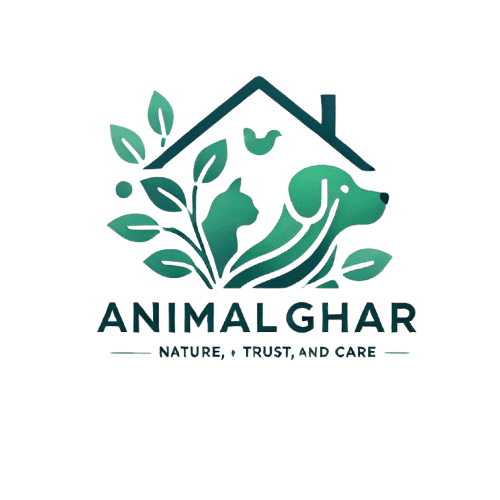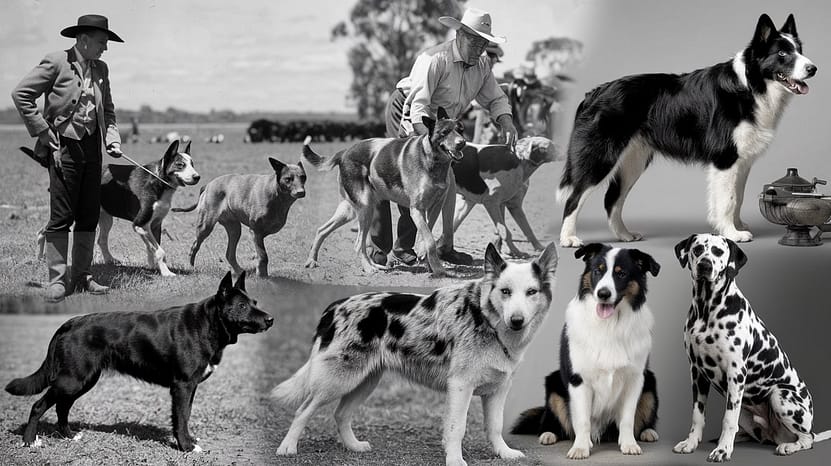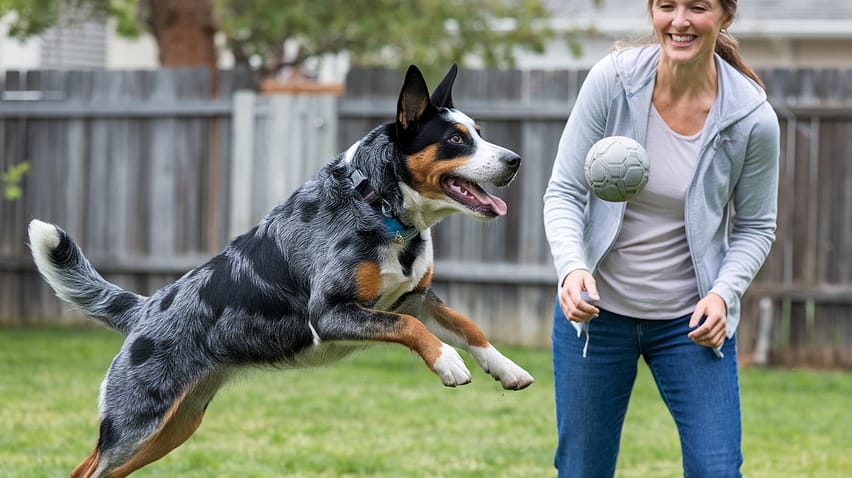Among the most clever and diligent canines on the planet are cow dogs. Before bringing an Australian Cattle Dog, American Cattle Dog breed, or Blue Heeler home, study their background, temperament, and care requirements.
This post will look at Australian Cattle Dog Fact:
- The background of livestock dogs—How did they grow into the perfect herding breed? Different cattle dog breeds—American vs. Australian variations
- What sets Australian Cattle Dog from Blue Heeler?
- Temperament and behavior issues—What to expect from this breed.
- Large cow dog breeds—Are there bigger herding dogs?
- Australian Cattle Dog daily schedule—How to keep them happy and healthy.
Whether you’re hunting for a working dog or a high-energy companion, this book will help you appreciate what makes cattle dogs so exceptional.
1. The History of Australian Cattle Dog Fact:
How They Became the Ultimate Herding Breed
Cattle dogs have a long history that dates back to the 19th century, when ranchers needed a strong, clever, and resilient canine to assist them in handling animals in tough settings.
The Origins of Cattle Dogs
- Early British settlers in Australia desired a dog that could survive harsh weather and long work hours.
- They began crossing Collies and Smithfield dogs with the native Dingo to make a harsher herding breed.
- Over time, breeds like the Dalmatian (for loyalty) and Bull Terrier (for strength) were added to boost their talents.
The Development of the Blue Heeler
- A breeder named Thomas Hall played a crucial role in refining the breed, creating what became known as the Hall’s Heelers.
- These dogs were later developed into what we now call the Australian Cattle Dog or Blue Heeler.
American Cattle Dog Breeds
- In the U.S., ranchers used breeds like the Catahoula Leopard Dog, Texas Heeler, and Black Mouth Cur to develop cattle-herding canines suitable to American settings.
- These breeds share some similarities with Australian Cattle Dogs but have distinct distinctions in look and temperament.
💡Fun Fact:
The term “heeler” originates from its particular herding technique—nipping at the heels of cattle to keep them moving!
2. Cattle Dog Breeds: American vs. Australian
There are several varieties of cow dogs, commonly categorized under American and Australian cattle dog breeds.
American Cattle Dog Breeds
These breeds were established for cattle herding in the United States:
- Texas Heeler—a crossbreed between the Australian Cattle Dog and Australian Shepherd.
- Catahoula Leopard Dog—Known for its unique coat and exceptional herding ability.
- Black Mouth Cur—a tough working dog, frequently utilized for both herding and hunting.
- McNab Dog—a lesser-known but very clever cow dog breed from California.
Australian Cattle Dog
The Australian Cattle Dog (ACD) is a compact, high-energy breed intended for herding cattle across long distances.
- American Foxhound Mix: Traits, Care, and Compatibility Guide
- Red Golden Retriever Puppy: 7 Diseases and Prevention Tips
Known for their stamina, intelligence, and agility, these dogs are one of the most popular herding breeds worldwide.
3. Australian Cattle Dog vs. Blue Heeler: What’s the Difference?
Many people use Australian Cattle Dog and Blue Heeler interchangeably, but is there a difference?
- Australian Cattle Dog—The breed’s official name.
- Blue Heeler—a nickname for Australian cattle dogs with a blue-speckled coat.
- Red Heeler—another moniker for people with a red-speckled coat.
💡 Bottom Line: All Blue Heelers are Australian Cattle Dogs, but not all Australian Cattle Dogs are Blue Heelers!
4. Australian Cattle Dog Temperament and Behavior Issues
Australian cattle dogs are recognized for their dedication, intelligence, and outstanding work ethic, but they also have some hurdles.These are some Australian Cattle Dog Fact-like traits or behavior issues
🐶 Positive traits:
- Highly Intelligent—They understand orders quickly and succeed in training.
- Loyal and Protective—They build wonderful bonds with their owners.
- Fearless and Confident—They don’t back down from challenge.
- Energetic and playful—perfect for energetic individuals or families.
⚠️ Common behavior issues:
- Excessive Nipping—Due to their herding instincts, they may nip at people’s heels.
- Disruptive Behavior—Without appropriate exercise, they might become restless and disruptive.
- Aggression Toward Other Animals—They can be territorial if not socialized early.
- Separation Anxiety—They don’t enjoy being left alone for long periods.
💡 Solution:
Proper training, sociability, and frequent exercise can help prevent these diseases.
5. Large Australian Cattle Dog Breeds Facts:
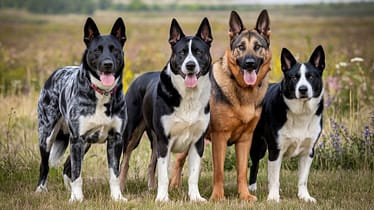
Most cattle dogs are medium-sized; however, some larger breeds also flourish at herding.
- Beauceron—a French herding breed with a powerful frame.
- Bouvier des Flandres—a big cattle-herding breed from Belgium.
- German Shepherd—Often deployed for police service despite being first bred for herding.
- 💡 If you require a huge cattle dog, these breeds give power, endurance, and intelligence.
6. Australian Cattle Dog Facts of Daily Routine:
Australian Cattle Dog Facts and its daily routine work shown blow:
Morning Routine:
- Exercise (30-60 minutes): running, trekking, or an intense game of fetch.
- Mental stimulation—puzzle toys or obedience training.
- Healthy Breakfast—High-protein dog food for prolonged energy.
Midday Activities:
- Training Session—Reinforce commands and work on new skills.
- Interactive Games—herding exercises or scent work.
Evening Routine:
- Final Walk or Playtime—Helps dissipate surplus energy before bedtime.
- Dinner—Followed by some quiet time.
- Bonding Time—Cuddles, grooming, or a peaceful chew toy session.
💡 Tip:
Without appropriate entertainment, Australian cattle dogs may acquire destructive tendencies like chewing and excessive barking.
Final Thoughts:
Is a Cattle Dog Right for You?
Cattle dogs—whether American, Australian, or Blue Heelers—are incredibly loyal, hardworking, and bright. However, they aren’t for everyone.
✔ Ideal Owners:
- Active individuals or families.
- People who have skill training for clever breeds.
- Those who can provide daily physical and mental stimulation.
❌ Not Recommended For:
- Apartment dwellers or those with low exercise levels.
- First-time dog owners without training expertise.
- Those who leave their pets alone for extended hours.
Their intelligence, activity, and loyalty make them a superb companion for the right person.
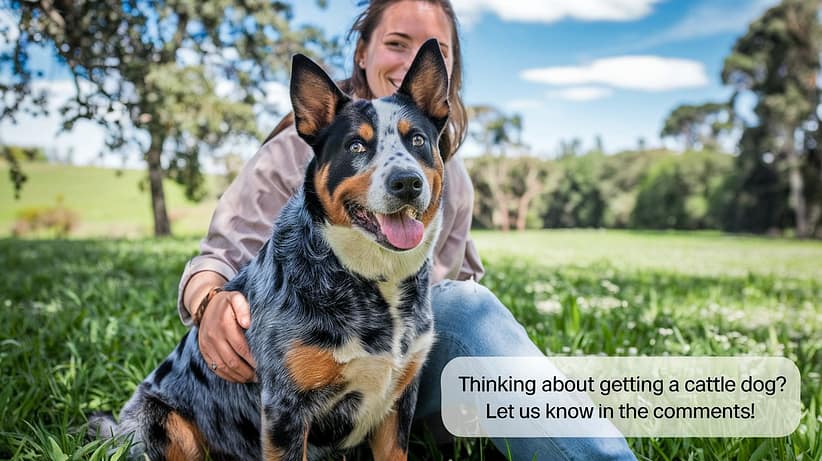
Do you own a cattle dog?
Share your experiences in the comments below! 🐕🔥
